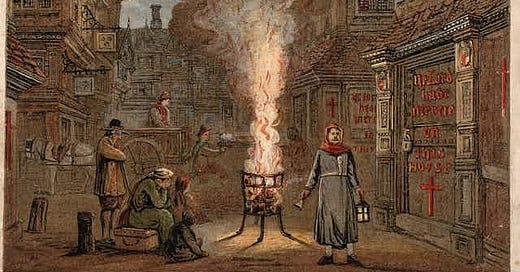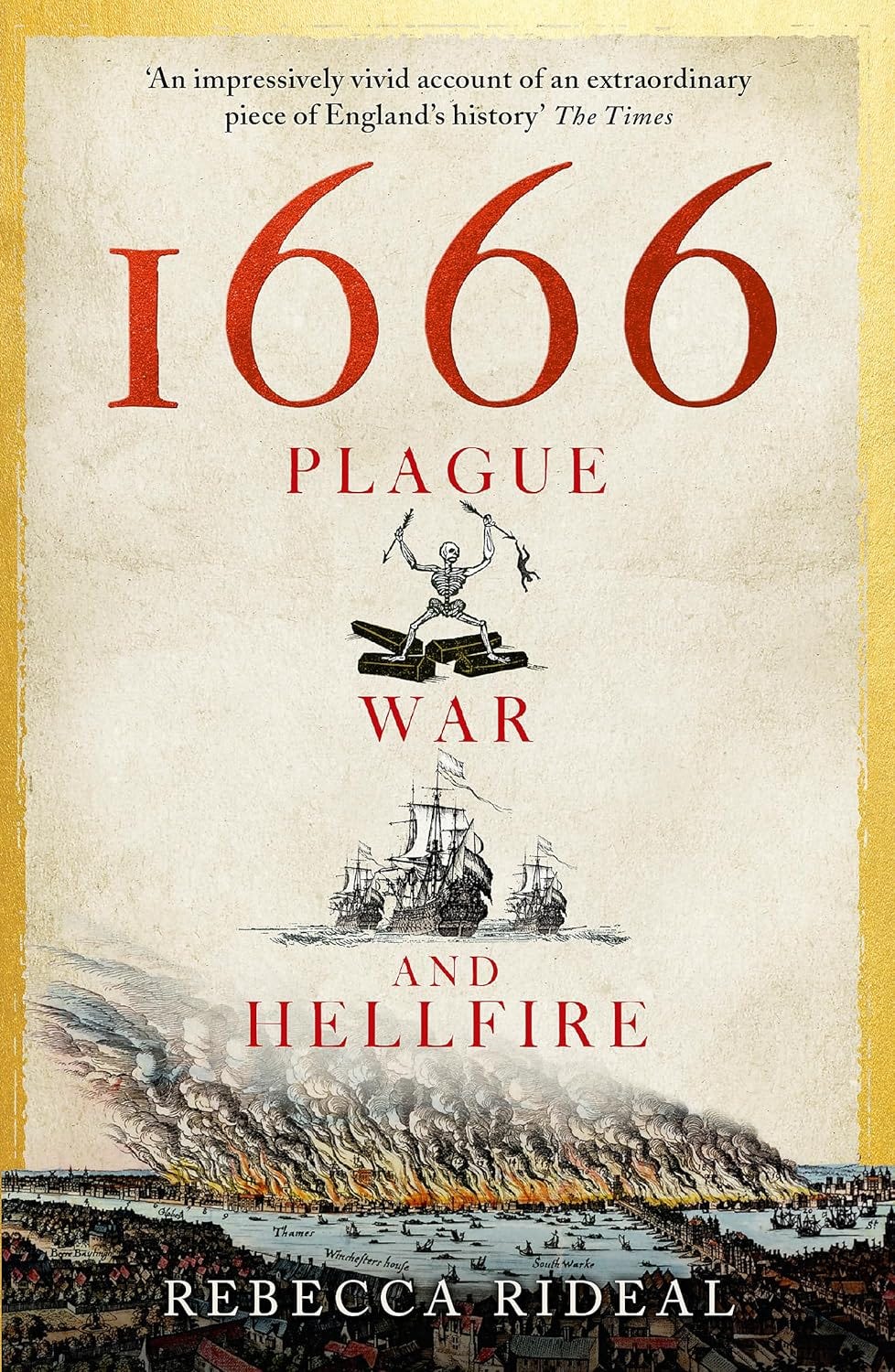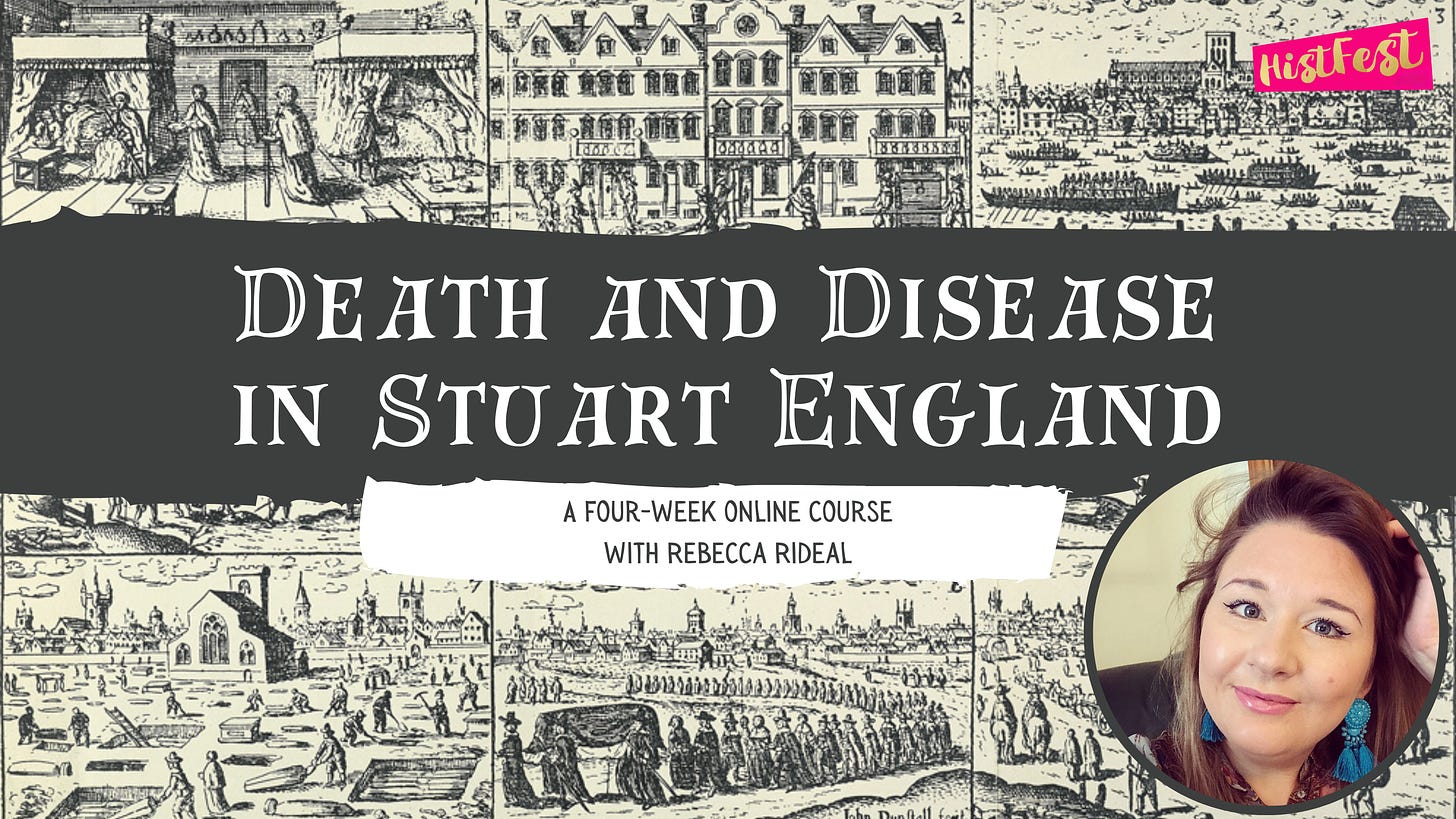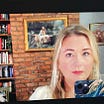“Now death rides triumphantly on his pale horse through our streets, and breaks into every house almost where any inhabitants are to be found.” Thomas Vincent (1665)
In 1665, bubonic plague hit London. It would claim an estimated 100,000 lives out of a population of around 400,000 to 500,000 people. Early Modern medicine was ill-equipped to deal with the symptoms, let alone cause of plague. Indeed, it was only in the late 19th century that scientists finally understood and named the plague bacterium Yersinia pestis, and it would take several decades more before antibiotics would be developed that could cure the disease.
Back in the 17th-century, scientific understanding rested on the theory of the Four Humours and ideas of Bad Air (‘Miasma’) and Good Air. So how did medical practitioners tackle the contagion? Pamphlets, tracts, letters, memoirs and diaries from the period can tell us a great deal. In my book, 1666: Plague, War and Hellfire, I highlight some of the preventative medicines and remedies that were recommended.
Dr Thomas Cocke advised the poor to force themselves to vomit if they suspected plague and to have a ‘hot posset drink’. He then suggested they ‘wash their mouth and hands with warm water and vinegar’. Like many who could afford it, the diarist Samuel Pepys chewed tobacco. Others turned to amulets and charms. Writing to her nephew who still remained in the city, one Lady Isham advised him to ‘to ware a quill as is filed up with quicksilver and sealed up with hard waxe & soed up in a silke thinge with string to ware about your neck’.
On one occasion there were rumours of a mineral-based medicine developed in France that could cure the plague. Many physicians were hopeful when samples were sent over, but found the ‘cure’ only worked to send ‘patients into their last sleep’ faster. Some thought that the consumption of ‘unwholsom meat (by reason of the great Rot among Sheep) eaten by the Poor last Year’ may have caused contagion. It was claimed that the nurses, usually women who had survived plague and therefore thought to be immune, recommended consuming human excrement as an antidote and encouraged the drinking of urine. In search of a remedy, one man who had found a carbuncle a little below his elbow applied a plaster to it. It turned gangrenous and scarification was needed, but the surgeon cut into a large vein and the man bled to death within three hours.
There was no harmony between those who treated the sick. Each family was supposed to be under the care of a nurse who would tend to their needs, but they were not always trustworthy characters. The physician Nathaniel Hodges lamented how ‘these wretches, out of greediness to plunder the dead, would strangle their patients and charge it to the distemper in their throats’. They were accused of ‘secretly convey[ing] the pestilent taint from sores of the infected to those who were well’. On one occasion, a nurse reportedly fell down dead under the burden of goods stolen from a house full of plague dead. Quack doctors didn’t miss the opportunity to make money from the ills of the time – one enterprising young man commissioned a paper advertisement that listed all the people he had ‘cured’ from plague with a miracle powder he had recently acquired, including four milk women in Covent Garden and ‘Rich. Pearce, his wife and his nurse’ on Bridges Street – but even qualified physicians were accused of being ready to take money but unable to offer a cure.
At the time of the plague Dr Nathaniel Hodges was in his mid thirties. The son of a Kensington vicar, he was born in London and attended Westminster School before heading to Cambridge in 1646, then transferring to Christ Church, Oxford. He qualified as a physician in 1659 and became a member of the College of Physicians in the same year, taking up residence in the parish of Walbrook, London. Clearly talented, while he did not challenge accepted medicine, he did put a great deal of weight on observation and real experience. Hodges meticulously noted the symptoms of plague as he witnessed them, commenting on the ‘rancid brackishness’ of victims’ vomit and the ‘frothy and fermentative nature of what was ejected by stool’. On one occasion he noted how the plague tokens were ‘not easily distinguishable from a Flea-Bite’. He rejected some treatments accepted by his contemporaries, such as powder from a unicorn’s horn and even bloodletting, which he said he ‘should pass it by as fatal’ and also acknowledged that the ‘moderate breezes’ of the summer should have been enough to ‘prevent the air’s stagnation and corruption’.
When he visited infected patients he ordered that they be put straight to bed and covered in woollen blankets to encourage sweating. Fires were made using juniper, fir, oak, elm and chestnut, but not coal – this he deemed to be impure. The infected were not allowed to change their clothes in case dampness from clean clothes unsettled them. He recommended a diet of ‘bread soaked in wine, poached eggs, juice of citrons, pomegranates, or elder vinegar, as well as chicken broths, gellies and wines’. Naturally, the very poor could not afford such a range of food and many died in ‘extreme languishing misery’.
The plague finally subsided towards the end of 1665, with the last few cases linked to the London Great Plague epidemic occurring in the first half of 1666. The disease was never seen in any significant way on English soil again. There have been many theories put forward as to why it never returned. While many of the theories are compelling, none have convinced me definitively. It is one of medical science’s great mysteries.
Studying disease and medicine can provide a fascinating window into life in Stuart England - from social histories and the role of the monarch, to the impact of disease on contemporaneous literature and art, and so much more.
If you’re interested in exploring these histories further, I am teaching a HistFest course on the subject next month. Death and Disease in Stuart England starts on Wed 12 June. You can follow ‘live’ or at your own pace and the course is available globally. I hope some of you can join me.









